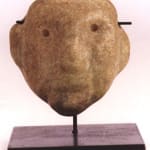Mayan Jade Mask Pendant, 500 CE - 900 CE
Jade
2
PF.2570
“Quetzalitztli (the name of the emerald green jade) comes from Quetzalli (Quetzal feather) and itztli (obsidian), because its appearance is like a green quetzal feather. And its body is as...
“Quetzalitztli (the name of the emerald green jade) comes from Quetzalli (Quetzal feather) and itztli (obsidian), because its appearance is like a green quetzal feather. And its body is as transparent and as dense as obsidian. It is precious, esteemed, valuable; it is worthy of being cherished; it merits storing; it is desirable, worthy of envy…” These are the words of 16th Century Spanish chronicler Sahagun, writing about new world jade and the highly evolved lapidary art he experienced during his travels in Mesoamerica. Miraculously enough, beautiful works of art such as this jade face pendant were created by the Maya not through the use of metal tools, for jade was too hard to be worked by the metals available to the Pre-Columbian Maya. Instead, the artist used only hard stones, bamboo, twine, sand and water. With these few materials, he sawed, carved, sanded, drilled, a braided and polished the raw jade to produce elegant works of art such as this stunning face pendant – a masterpiece of jade carving that is dramatically appealing to all who experience its spirited beauty. Perforated on either side, perhaps this face pendant was worn by an Ancient Mayan an amulet, imbuing the wearer with its mystical powers. Whatever its previous function may have been, today we are captivated by its spell, and in awe of the artist whose creative efforts produced this dramatic work of Ancient Mayan art.
Literature
V11



